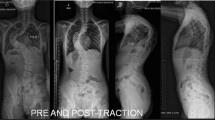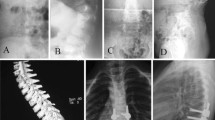Abstract
Purpose
Severe rigid spine deformity with sharp curve can be effectively corrected by posterior vertebral column resection (PVCR). Meanwhile, high risk of this procedure also has been recognized generally. The aim of this study is to review and evaluate the role of preoperative skull-femoral traction prior to PVCR for extremely severe rigid spinal deformity with sharp angular curve >150°.
Methods
Twelve cases with extremely severe rigid deformities and sharp curves were treated by skull-femoral traction before operation. For them, the mean preoperative major scoliotic curve and kyphosis were 153° (110°–168°) and 109° (61°–180°). Continuous skull-femoral traction in supine position was started 4 weeks before operation. In the process of traction, tolerance, neurologic status, deformity changes, etc., were reviewed and documented for analysis. PVCR were performed in all these patients for final and main correction.
Results
The final traction force in the 12 cases was 63 % of body weight. After 4-week traction, the main scoliotic curve and kyphosis were decreased by 34 and 31 %. In 1 week, main scoliotic curve and kyphosis were decreased by 19 and 15 %. In 2 weeks, the major scoliosis curve was decreased by 11 %, but kyphosis was unexpectedly increased by 4 %. Deformity in the last 2 weeks was less significant than the first 2 weeks. After PVCR, the main scoliotic curve and kyphosis were improved 69 and 66 %. No permanent neurological damage occurred.
Conclusion
Preoperative skull-femoral traction effectively mitigates the neurological risks of PVCR for extremely severe rigid spinal deformity with sharp curve. During traction, scoliosis can be improved more significantly and easily than kyphosis.



Similar content being viewed by others
References
Suk SI, Kim JH, Kim WJ et al (2002) Posterior vertebral column resection for severe spinal deformities. Spine 27:2374–2382
Xie J, Wang Y, Zhao Z et al (2012) Posterior vertebral column resection for correction of rigid spinal deformity curves more Than 100. J Neurosurg: Spine 17:540–551
Xie J, Li T, Wang Y et al (2012) Change in Cobb angle of each segment of the major curve after posterior vertebral column resection (PVCR): a preliminary discussion of correction mechanisms of PVCR. Eur Spine J 21:705–710
Heary RF, Madhavan K (2008) The history of spinal deformity. Neurosurgery 63(3 Suppl):5–15
Walick K, McClung A, Sucato DJ et al (2008) Halo-gravity traction in severe pediatric spinal deformity (abstract). In: The 43rd Annual Meeting of the Scoliosis Research Society, Salt Lake City, US,12 Sept 2008
Sink EL, Karol LA, Sanders J et al (2001) Efficacy of perioperative halo-gravity traction in the treatment of severe scoliosis in children. J Pediatr Orthop 21:519–524
Rinella A, Lenke LG, Whitaker C et al (2005) Perioperative halo-gravity traction in the treatment of severe scoliosis and kyphosis. Spine 30:475–482
Sucato DJ (2010) Management of severe spinal deformity scoliosis and kyphosis. Spine 35:2186–2192
Tokunaga M, Minami S, Kitahara H et al (2000) Vertebral decancellation for severe scoliosis. Spine 25:469–474
Park DK, Braaksma B, Hammerberg K et al (2009) The effect of long-term halo traction in pediatric deformity (abstract). In: The 16th International Meeting on Advanced Spine Techniques (IMAST), Vienna, AT, 15–18 Jul 2009
Koller H, Zenner J, Gajic V et al (2012) The impact of halo-gravity traction on curve rigidity and pulmonary function in the treatment of severe and rigid scoliosis and kyphoscoliosis: a clinical study and narrative review of the literature. Eur Spine J 21:514–529
Xie J, Zhang Y, Wang Y et al (2014) The risk factors of neurologic deficits of one-stage posterior vertebral column resection for patients with severe and rigid spinal deformities. Eur Spine J 23:149–156
Jeszenszky D, Haschtmann D, Kleinstück FS et al (2014) Posterior vertebral column resection in early onset spinal deformities. Eur Spine J 23:198–208
Zeng Y, Chen Z, Qi Q et al (2013) The posterior surgical correction of congenital kyphosis and kyphoscoliosis: 23 cases with minimum 2 years follow-up. Eur Spine J 22:372–378
Boachie-Adjei O, Papadopoulos EC, Pellisé F et al (2013) Late treatment of tuberculosis-associated kyphosis: literature review and experience from a SRS-GOP site. Eur Spine J 22(4 Suppl):641–646
Bradford DS, Tribus CB (1997) Vertebral column resection for the treatment of rigid coronal decompensation. Spine 22:1590–1599
Lenke LG, O’Leary PT, Bridwell KH et al (2009) Posterior vertebral column resection for severe pediatric deformity: minimum two-year follow-up of thirty-five consecutive patients. Spine 34:2213–2221
Cheh G, Lenke LG, Padberg AM et al (2008) Loss of spinal cord monitoring signals in children during thoracic kyphosis correction with spinal osteotomy: why does it occur and what should you do? Spine 33:1093–1099
Bridwell KH, Lenke LG, Baldus C et al (1998) Major intraoperative neurologic deficits in pediatric and adult spinal deformity patients. Incidence and etiology at one institution. Spine 23:324–331
MacEwen GD, Bunnell WP, Sriram K (1975) Acute neurological complications in complications of Halo Use in the treatment of scoliosis: a report of the Scoliosis Research Society. J Bone Joint Surg Am 57:404–408
Limpaphayom N, Skaggs DL, McComb G et al (2009) Complications of halo use in children. Spine 34:779–784
Koptan W, ElMiligui Y (2012) Three-staged correction of severe rigid idiopathic scoliosis using limited halo-gravity traction. Eur Spine J 21:1091–1098
Watanabe K, Lenke LG, Bridwell KH et al (2010) Efficacy of perioperative halo-gravity traction for treatment of severe Scoliosis (≥100). J Orthop Sci 15:720–730
Conflict of interest
None.
Author information
Authors and Affiliations
Corresponding author
Rights and permissions
About this article
Cite this article
Wang, Y., Xie, J., Zhao, Z. et al. Preoperative short-term traction prior to posterior vertebral column resection: procedure and role. Eur Spine J 25, 687–697 (2016). https://doi.org/10.1007/s00586-014-3752-6
Received:
Revised:
Accepted:
Published:
Issue Date:
DOI: https://doi.org/10.1007/s00586-014-3752-6




